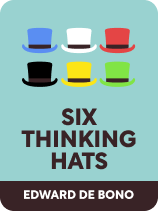

This article is an excerpt from the Shortform book guide to "Six Thinking Hats" by Edward de Bono. Shortform has the world's best summaries and analyses of books you should be reading.
Like this article? Sign up for a free trial here .
What is red hat thinking from Six Thinking Hats? What type of thinking does the ret hard represent?
In Edward de Bono’s book Six Thinking Hats, the red hat is the emotional hat. The wearer of this hat must share their raw, unjustified emotions about a situation without analyzing why they feel the way they do.
Keep reading to learn when and why the red hat should be worn.
The Red Hat
The red hat is the emotional hat. Red hat thinking is pure emotion. Red is the color of blood, symbolizing strong emotions like passion and anger.
The red hat is the opposite of the white hat. The white hat wants pure facts, stripped of emotion and agenda. The red hat wants your emotions, intuitions, and gut feelings about the issue, with no need for supporting evidence or explanations.
Red Hat Questions
While you’re wearing the red hat, consider these questions:
- Do I like this?
- How do I feel about this person?
- What’s my intuition telling me?
- Exactly what emotions am I experiencing around this issue?
Red Hat Data
Red hat contributions are simple statements of emotion. They don’t have to be justified or justifiable—in fact, while wearing the red hat you’re specifically discouraged from providing explanations.
Examples of red hat contributions are:
- “This seems like a terrific investment to me. I’m feeling really keen.”
- “I don’t know what it is exactly, but something about this deal smells fishy.”
- “I like this person. I feel good about doing business with her.”
- “We’re getting a lot out of this arrangement, but it doesn’t really seem fair to the other party.”
Key Red Hat Concepts
Red hat data includes emotions, intuitions, and gut feelings.
Emotions
Feelings are extraordinarily diverse in terms of intensity, quality, and duration. All are welcome under the red hat. It’s common to disparage emotions in the workplace, but in reality emotions are necessary for proper thinking, and they play an important role in any decision. In fact, any final decision needs to feel good as well as being intellectually justifiable.
Suppressing emotions just makes them pop up again cloaked in rationality. The red hat allows people to express their emotions fully and honestly, without needing any justification or rationalization. A bonus is that after people have been given the opportunity to express their feelings, it’s often easier for them to set aside these emotions and engage in other types of thinking.
Intuitions
The word “intuition” can be misleading, as we use it to refer to two different things:
- A flash of inspiration. This might completely change your perception of a problem you’re working on, or offer a solution that was right in front of your eyes the whole time.
- A quick assessment of a situation based on significant previous experience.
Red hat intuition is the second type: What do you feel about this situation, if you look at it through the lens of your accumulated previous experiences? The first type of intuition belongs under the green hat, where you’re looking at established mental patterns and figuring out how to break them.
Gut Feelings
Gut feelings are premonitions you have about the outcome of a situation (for example, “You know, I just can’t see this ending well for anybody.”) Some gut feelings have obvious explanations, while others are more mysterious.
Most people aren’t very good at working with gut feelings. They either let the feeling determine the decision, using one-sided white hat information and either yellow or black hat analysis to support the feeling, or they repress the gut feeling and attempt to proceed using logic only. Neither of these approaches is ideal. Under the red hat, people’s hunches and gut feelings form an important part—but only one part—of the overall picture that will be used to determine the path forward.
How to Use the Red Hat
- Emotions change fast. It’s possible to refine and modulate even very deep-seated emotions through discussion and over time. Because of this, it’s good practice to return to the red hat several times during a discussion. For example, you might want to do some red hatting at the start to check people’s initial reactions, and some more in relation to potential solutions.
- You can apply the red hat to procedural issues. At the end of the meeting, after the final blue hat, consider red hatting briefly to find out people’s feelings about the whole discussion process.
Advice for Facilitators
- If there are very strong emotions on a particular issue, consider invoking the red hat early in the discussion to clear the air.
- Under this hat, seek to get to the core of the emotion quickly. Actively discourage explanations and justifications. You can do this by allocating only a very short amount of time, say 30 seconds, per person.
- Feelings often change following detailed discussion. Aim to guide the discussion back to the red hat several times to monitor these changes.
Exercise: Try on the Red Hat
Work with the red hat on a problem of your choice.
- Consider the project or initiative that you started thinking about in the last exercise. What emotions do you feel about this issue? Remember, no explanations or justifications are necessary.
- What intuition do you have about this project, based on previous experience?
- What’s your gut feeling about how this will all turn out?

———End of Preview———
Like what you just read? Read the rest of the world's best book summary and analysis of Edward de Bono's "Six Thinking Hats" at Shortform .
Here's what you'll find in our full Six Thinking Hats summary :
- A handbook for training people to think more efficiently and productively
- An explanation of each of the six thinking hats created by Edward de Bono
- How to calm your inner critic and dramatically cut your decision-making time






